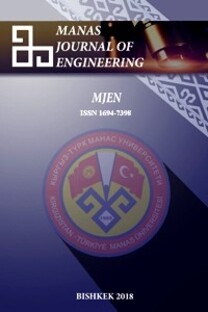Determination and assessment of phosphorus assimilation capacity applying Vollenweider approach for Hazar Lake
Determination and assessment of phosphorus assimilation capacity applying Vollenweider approach for Hazar Lake
___
- [1]. Vollenweider R.A., “Advances in defining critical loading levels for phosphorus in lake eutrophication”, Mem. 1st ital. Idrobiol., 33, (1976), 53–58.
- [2]. Håkanson L., Bryhn A.C., Hytteborn J.K., “On the issue of limiting nutrient and predictions of cyanobacteria in aquatic systems”, Sci. Total Environ., 379, (2007), 89–108.
- [3]. Ekholm P., “N: P ratios in estimating nutrient limitation in aquatic systems”, Finnish Environ. Inst., (2008), 11– 14.
- [4]. Sterner R.W., “On the phosphorus limitation paradigm for lakes”, Int. Rev. Hydrobiol., 93, (2008), 433–445.
- [5]. Jones R.A. Lee G.F., “Use of Vollenweider-OECD modeling to evaluate aquatic ecosystem functioning”, Funct. Test. Aquat. Biota Estim. Hazards Chem., ASTM STP 988, J. Caims, Jr., and J.R. Pratt, Eds., American Society for Testing Materials, Philadephia, (1988), 17-27.
- [6]. Ryding S.-O., Forsberg C., “Short-term load-response relationships in shallow, polluted lakes”, In Hypertrophic Ecosyst., Springer, (1980), 95–103.
- [7]. Jones J.R., Bachmann R.W., “Prediction of phosphorus and chlorophyll levels in lakes”, J. (Water Pollut. Control Fed., (1976), 2176–2182.
- [8]. Schindler D.W., “Factors regulating phytoplankton production and standing crop in the world’s freshwaters”, Limnol. Oceanogr. 23, (1978), 478–486.
- [9]. Chapra S.C., “Total phosphorus model for the Great Lakes”, J. Environ. Eng. Div., 103, (1977), 147–161.
- [10]. Canfield Jr D.E., Bachmann R.W., “Prediction of total phosphorus concentrations, chlorophyll a, and Secchi depths in natural and artificial lakes”, Can. J. Fish. Aquat. Sci., 38, (1981), 414–423.
- [11]. Sonmez F., Kocer M.A.T., Alp M.T., Sen B., “An Evaluation On Characterıstıc Diatoms Of Alkaline Lake Hazar (Turkey)”, Feb-Fresenıus Environ. Bull., (2018), 8519.
- [12]. Håkanson L., Jansson M., “Principles of lake sedimentology”, vol. 109, Springer-verlag, Berlin, (1983), pp. 24-31.
- [13]. Emmanuel E., Keck G., Blanchard J.-M., Vermande P., Perrodin Y., “Toxicological effects of disinfections using sodium hypochlorite on aquatic organisms and its contribution to AOX formation in hospital wastewater”, Environment international, 30, (2004), 891-900.
- [14]. Nürnberg G.K., “Trophic state of clear and colored, soft-and hardwater lakes with special consideration of nutrients, anoxia, phytoplankton and fish”, Lake Reserv. Manag., 12, (1996), 432–447.
- [15]. Vollenweider R. A., “Eutrophication of waters: monitoring, assessment and control”. Organisation for Economic Co-operation and Development; Washington, DC: Sold by OECD Publications and Information Center, 1982.
- [16]. Whittaker R.H., “Communities and ecosystems”, Communities Ecosyst., Macmillan Publishing Co., Inc., New York, USA, 1975.
- [17]. Vollenweider R.A., Kerekes J., “OECD cooperative programme for monitoring of inland waters (eutrophication control)”, Synth. Report. OECD, Paris, 1980.
- [18]. Kocer M.A.T., Şen B., “Some factors affecting the abundance of phytoplankton in an unproductive alkaline lake (Lake Hazar, Turkey)”, Turk. J. Botany., 38, (2014), 790–799.
- [19]. Ayaz S., “Hazar Lake Management Plan Project I. Stage”, TÜBİTAK MRC, Energy Systems and Environment Institute, 2002.
- [20]. Varol M., “Stream Inputs To Lake Hazar (Eastern Anatolia-Turkey)”, Environ. Eng.Manag. J., 18, 1, (2019), 185-194.
- [21]. Kocer M.A.T., Şen B., “The seasonal succession of diatoms in phytoplankton of a soda lake (Lake Hazar, Turkey)”, Turk. J. Botany., 36, (2012), 738–746.
- [22]. TURKSTAT, “Turkish Statistical Institute 2020 Reports”, Available: https://www.tuik.gov.tr/ [Accessed:April 13, 2021]
- [23]. TÜBİTAK MRC, “HHAP Project Determination of Sensitive Areas and Water Quality Objectives for Turkish River Basin Districts Project (2012–2015)”, TÜBİTAK MRC, Environment and Cleaner Production Institute, 2016
- [24]. Baird R.B., “Standard Methods for the Examination of Water and Wastewater”, 23rd ed., Water Environment Federation, American Public Health Association, American Water Works Association, 2017.
- [25]. YSKY, “Regulation on Surface Water Quality (RSWQ) (Turkey) (2016) 29797/ 16.8.2016”, Ministry of Forestry and Water Affairs, Available: https://www.resmigazete.gov.tr/eskiler/2016/08/201608 10-9.htm. [Accessed: April 13, 2021]
- [26]. Phillips G., Pietiläinen O.-P., Carvalho L., Solimini A., Solheim A.L., Cardoso A.C., “Chlorophyll–nutrient relationships of different lake types using a large European dataset”, Aquat. Ecol., 42, (2008), 213–226.
- [27]. Sonmez, F., Sen, B., “Seasonality and Distribution of Epilithic Diatoms in an Alkaline Lake (Lake Hazar, Elazig, Turkey)”, Fresenius Environmental Bulletin, 20, (6), 1458-1464.
- [28]. Şen B., Alp M.T., Özrenk F., Ercan Y., Yıldırım V., “A study on the amount of plant nutrients and organic matters carried into the Hazar Lake (Elazığ-Türkiye)”, Fresenius Environ. Bull., 8, (1999), 272–279.
- ISSN: 1694-7398
- Yayın Aralığı: 2
- Başlangıç: 2001
- Yayıncı: KIRGIZİSTAN-TÜRKİYE MANAS ÜNİVERSİTESİ
Exergy analysis of petroleum refinery hydrogen network integration based on reaction system
Fatma Zehra Ozcelik, Ozben Kutlu
Şakir Yılmaz, Ümit Ecer, Tekin Şahan
Synthesis, spectroscopy, and photophysical properties of newly magnesium (II) phthalocyanine
Ömer Faruk Öztürk, Mehmet Pişkin, Zafer Odabaş
Karwan Talaat Mohammed, Muhamad Arshad Javed, Fahru Huyop, Yilmaz Kaya
